You might have to be bored
Or Angry
Or Apathetic
To hack people in the streets,
on their way to the grocers,
with machetes.
It could be on the radio
Or a sermon you heard
Or your fat bastardly neighbour
A little bird?
Here is a mob.
Your mob.
Practice your swings
Think of the time
you played tennis with
your cousin
at the youth club and
won,
when you throw a backhand.
You must be warned of the
drop
splatter
outpour
that flows and
stains.
But remember,
power
in numbers and also,
wash your beige dress shirt when
you get home,
The one you wear to work.
Give your kids hints on their homework
but not the solutions
and tell them about your day
when you kiss them
goodnight.
Tomorrow it will
begin
again.
Tuesday, March 23, 2010
Practice your swings
Sunday, March 21, 2010
A Family’s Heartbreak: A Parent’s Introduction to Parental Alienation
By:Mike Jeffries
A Family’s Heartbreak: A Parent’s Introduction to Parental Alienation, is the true story of one parent’s struggle to maintain a normal, loving relationship with his young son in the face of overwhelming odds. From the emotionally devastating actions of the child’s other parent, to a court system and mental health community ill-equipped to deal with a destructive family dynamic, A Family’s Heartbreak: A Parent’s Introduction to Parental Alienation is both an education in parental alienation and an eye opening experience for parents who don’t believe this could happen to them.

Introduction to A Family’s Heartbreak
IN THE SPAN OF SEVEN DAYS I filed for divorce, was arrested and falsely accused of child abuse. I also walked into a clinic with all the symptoms of a heart attack. But you know what? Those events were the high points of my week. Divorce, arrests, child abuse charges and heart attacks are like marching in the Disney World parade compared to the world of parental alienation.
The concept of parental alienation is pretty simple – one parent deliberately damages, and in some cases destroys, the previously healthy, loving relationship between his or her child and the child’s other parent. In a severe case the alienating parent and child work together to successfully eliminate the previously loved Mom or Dad from the child’s life.
My introduction to parental alienation began on the night of July 14, 2004. Until that night my 11-year-old son and I had a wonderful relationship. By the early morning hours of July 15, 2004 we didn’t have a relationship.
I know what you’re thinking – a normal, healthy father/son relationship doesn’t go from hugs to heartbreak in a few hours. I believed the same thing. I was wrong. Parental alienation is like a train barreling through a dark tunnel with its lights off. I was standing in the middle of the tracks when the train emerged from the darkness. I never saw it coming.
Of course, now I can look back and say I should have at least heard the train coming. Now I can point to things my then-wife said to my son one and even two years before that might have set off alarms in my mind. But my son and I had a normal, healthy relationship. I couldn’t conceive that any parent would do something so emotionally destructive to his or her child. What I didn’t realize is that a variety of emotional issues could combine with the anger, hurt and bitterness of divorce to drive some people to unimaginably vindictive and destructive heights.
On that July night my attorney hadn’t even finished drafting my divorce complaint when my future ex-wife started screaming at me within earshot of my son. According to her I was solely responsible for our impending divorce. “Your father is abandoning us,” she told him.
My ex-wife had my son sleep in her bed that night. He was still sleeping in her bed when I moved out of the house one month later. “I need you to protect me,” she kept telling him.
Before I moved out, I couldn’t even get him to have dinner with me. “Please don’t leave me,” Mom begged him. “I don’t want to be alone.”
I’ve learned a lot about parental alienation since those first nights. I’ve had a lot of time on my hands. As I write this, I haven’t spent any time alone with my son in almost three years.
One thing I’ve learned is that an alienating parent is only interested in filling his or her unhealthy emotional needs at the expense of the other parent and their child. The alienating parent doesn’t understand that he or she is also hurting the child by forcing the kid to choose a side in the parental conflict.
I’ve also learned that parental alienation is not just a single crime against the other parent, but three crimes against the child.
The first crime is that the alienating parent doesn’t acknowledge that every child is one half of each parent. Every time the alienating parent tells the child how horrible the other parent is, the alienating parent is telling the child that half of him (or her) is horrible.
The second crime is that the alienating parent teaches the child that cutting off contact with people is an acceptable way to handle anger, hurt and disappointment. The world is full of people. One day the child will be an adult. The child will grow up without the appropriate coping skills to have normal, healthy relationships with other adults.
The third crime is that one day the child will look back on the alienating parent’s behavior from an adult perspective. He or she will then realize that the alienating parent robbed the child of something very precious – the love and attention of the other parent. The child-turned-adult will realize that the trust placed in the alienating parent was misplaced. He or she will feel betrayed. At that point the adult will not just have one damaged relationship with a parent, but damaged relationships with both parents.
The third crime is the worst crime of all.
I’ve learned so much about parental alienation I decided to write this book. But before you read any further there’s something you should know. I’m not a psychologist. I’m not a lawyer. I’m just a Dad. That’s all. A long time ago I would have identified myself as a journalist, but my last byline was during President Ronald Reagan’s administration. The statute of limitations on my journalism credentials expired long ago.
Yet my old journalism experience came in handy when I started studying parental alienation. My goal was to regain my relationship with my son. I knew I lived on an emotional roller coaster of anger, depression, helplessness and disillusionment. How were these emotions affecting my ability to achieve my goal? I couldn’t imagine what my son was living through. How could I address his issues when I didn’t even know what they were? What about family court judges, attorneys, family relation counselors, psychologists, and even the police? How could these divorce-war veterans help, or hurt, my chances of ever having a normal relationship with my son again?
I approached parental alienation like a journalist approaching a news story. I gathered the facts. I interviewed a variety of people – therapists, attorneys and victims. And I passed on everything I learned to the psychologists, attorneys and counselors involved in my case.
Guess what? Many of these professionals had never heard of parental alienation. And the few that had heard of it didn’t really understand how to approach a severe case legally or therapeutically. During my crash course in parental alienation I found lots of valuable books on children and divorce. These books discussed alienation-type symptoms, but few books tackled parental alienation head on.
One book that did tackle the subject was Dr. Richard Gardner’s The Parental Alienation Syndrome. Gardner’s book became my bible. I quoted Gardner chapter and verse when I talked to people involved in my case. But Gardner wrote his book for psychologists and attorneys. On the title page of The Parental Alienation Syndrome, Gardner even calls his book “a guide for mental health and legal professionals.” Naturally, Gardner used a lot of legal and psychological jargon to explain parental alienation.
Since Gardner talked about the life of an alienated parent in clinical terms, I wrote A Family’s Heartbreak: A Parent’s Introduction to Parental Alienation to address alienation in human terms. The book is based on a true story. I wrote it from a parent’s perspective. There’s a big difference between clinically dissecting the anatomy of an alienated parent and being on the receiving end of the alienating behavior. Think about the difference between studying a driver’s manual and climbing behind the wheel of a car for the very first time. Reading the manual doesn’t quite measure up to stepping on the gas pedal.
Since I’m not a psychologist, I left the psychological analysis in this book to a professional with experience helping parental alienation families. I shared my story with him. You can sit in on our “sessions” and hear him clinically explain parental alienation. I’ll also give you my perspective on parental alienation. I’ve learned a lot about the legal and psychological professionals forced to deal with this relatively new phenomenon. Perhaps my perspective will save you some time and money. Maybe my experience will help convince legal and mental health professionals that parental alienation is not something they can just dismiss as “bad parenting.” Most of all, I hope my experience will help your family avoid what my family went through.
A big part of this book relates examples of alienating behavior. Each one is true. I’ve presented some of these examples in the form of a journal. This isn’t merely a writer’s technique. I really kept a journal in the years leading up to and immediately following my divorce. How the journal developed is a story in itself.
At first I told myself I was keeping a journal because I would never remember all the incredible but true events I would need to remember if my divorce went to trial. I was right on both counts. We went to trial, and a large portion of my testimony focused on my future ex-wife’s alienating behavior. I wouldn’t have remembered a fraction of that behavior without the journal. I highly recommend keeping a journal to anyone who anticipates a nasty trial and child custody battle.
I also discovered that keeping a journal is good therapy. There were many times during my ordeal when I became frustrated or angry. My overwhelming desire at those times was to call someone, anyone, involved in my case and just start yelling. Writing down my frustrations rather than subjecting someone to them was a much better way to handle my emotions.
One day I was writing in my journal when the old journalist inside me re-emerged. I began thinking about parental alienation as a story that needed telling. I found myself editing my journal entries like a copy editor – shortening sentences, comparing verb tenses and double-checking facts. At that point I began not only writing for me but also for you.
Since I was writing for both of us, I had to make some decisions on your behalf. I edited the story heavily to keep the focus on alienation rather than divorce. I also grouped similar examples of alienating behavior together in the journal chapters to illustrate certain concepts better. Finally, I had to make a decision on the use of gender and pronouns when talking about parents and children.
I couldn’t write an entire book writing Mom or Dad, him or her, he or she, every time I referred to a parent. In some chapters I thought it was important to remain gender neutral in my references to the alienating parent. Despite my best efforts, you’ll notice how awkward the language became. So in other parts of the book I picked a gender for the alienating parent, the alienated parent and the alienated child and stuck with those choices. I also had to decide whether to discuss the alienated child in the singular “child” or the plural “children.” So in the pages that follow the alienating parent is generally described as female. The alienated parent is male. The alienated child is male and referred to in the singular rather than the plural.
To be honest, I didn’t spend much time considering alternatives. I am an alienated father, I was married to an alienating mother and my son is an alienated child. I tried not to confuse either of us by using one set of pronouns to tell my family’s story and another set of pronouns for generic references.
I sincerely apologize to all alienated Moms if I make it appear that only Dads are victims of parental alienation. Fathers successfully alienate children from mothers too. I’ve heard from many alienated mothers who are suffering the pain and heartache that only an alienated parent can know. I decided to title this book, A Family’s Heartbreak: A Parent’s Introduction to Parental Alienation, because Moms, Dads and children are victims of alienating behavior. In the final analysis, an alienating parent is an alienating parent – regardless of gender. If alienated mothers were to change all my male references to female references and vice versa, the examples and explanations of parental alienation would apply equally to them.
Another decision I had to make was whether to follow Dr. Richard Gardner’s lead and write about parental alienation as a syndrome, PAS, or focus on parental alienation behaviors. In this case I did spend a long time considering my decision.
I ultimately decided to drop “Syndrome” from all my parental alienation references because PAS isn’t in the DSM — the psychology profession’s Diagnostic and Statistical Manual. The manual is the clinician’s bible – a guide to symptoms and syndromes and the definitive diagnosis on any legitimate mental health condition.
PAS may not be in the DSM, but alienating behavior still inflicts pain, heartache and incalculable emotional damage on the children, parents and extended family members involved in these horrible situations. Parents on the receiving end of alienating behavior don’t really care if professionals classify the behavior as a syndrome or a bad alignment of the stars and planets. They just want someone to help them restore their previously normal, loving relationships with their children.
I believe one day mental health professionals will classify parental alienation as a “Syndrome.” Until then, I am quite comfortable writing about “parental alienation” as behavior and let others debate what to call this very destructive family dynamic. However, I did use the phrase “Parental Alienation Syndrome” or “PAS” in this book when I discussed or quoted other professionals who used the phrase in their work.
I didn’t plan on writing the definitive work on parental alienation and in that respect I’ve succeeded. Writers do their best work writing about their experiences. Not all alienation cases resemble my family’s story. An alienated parent needs to examine his or her own personal situation and consult with professionals before completely understanding the circumstances of his or her own case. But whether you are male or female, I hope this story helps you find some answers, comfort and solutions to your alienation nightmare.
I also hope you become outraged that parents alienate their children from the other parent. I hope you become further outraged that judges, attorneys and many mental health professionals consider the actions of an alienating parent just part of a normal day at the office when working divorce and child custody cases. I hope you recognize that parental alienation is a form of emotional child abuse that we can’t ignore any longer.
Most of all, I hope that this book, in some small way, helps alienated parents and children begin rebuilding their previously loving relationships.
By:Mike Jeffries
ABP World Group International Child Recovery Service
Visit our web site at: www.abpworld.com
My Source Of Inspiration...
… is not going to be a single one, naturally (and fortunately). But, one of them can certainly look like this:

That is right, I am talking about bright eyes here. And as long as they are shining, the world is continuing to exist.
The photograph however was not taken by me, it just stands symbolically since I do not publish my own very personal ones (at least not now). So, please take a note that this photo is originally taken from Flickr, and more explicit the user Michael Spear Hawkins. Yes indeed, children can be so enlightening and spirited, it is just a pleasure. But who knows if I will have own children one day, too…
And, I am obligated to say that I made three minor changes in editing the picture. First, I added a little contrast I brightness (please compare, only a little). Second, I added a little grey border (as you can see). Third, and that is the most interesting change, I changes the eye colour (a little more towards blue).
Of course, if anyone feels not right with that (of those who have the copyright – naturally), please inform me right away so I can remove the picture.
Greetings, and stay inspired, Ikarus
p.s. maybe I will publish some of my own pictures of 2009-2010 soon.
Saturday, March 20, 2010
The 50 Foot Snowball Launcher - new age canon to fire the ice

Do you remember playing paintball with your friends and getting scolded from your mom for making those clothes dirty with colors? This new device is the new aged gun which is not only much safer than paintball but its real fun too because now you can launch snowballs up to a distance of 50 feet, giving your enemy absolutely no time to think or run.

This cool toy canon “50 foot Snowball Launcher” which is here to destroy all your enemies by allowing long ranged and rapid assaults during a snowball war at your neighborhood. It’s powered by Elastomer and works on the sling shot mechanism to throw three perfectly spherical snowballs at a time, one by one, without being charged by batteries.
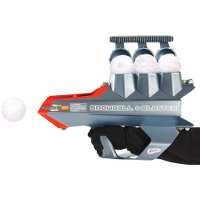
With a stylish frame, handle along with a proper sight alignment, sight picture and front sight focus, this is the perfect equipment for the hunter. The best thing about this gun is that it is made up of cold-withstanding plastic so that you can play throughout the day without breaking your gun. Its best for ages from 8 up to 17 but even the daddies and mommies can buy this for themselves if then want to play with their child or to bring back their old times when they used to throw snowballs on their friends. Its dimensions are 1/2″ L x 5 1/2″ W x 12″ H. (2 1/2 lbs.) It’s available for $29.95.
Our street is coming together
What a neat week. We had a ton of rain last weekend and our
neighbors’ basement had a foot of water in it. We’re all helping each other out. My next door neighbor, who has congestive heart failure and a real painful back condition, offered up her washer and dryer to the neighbors with the flooded basement. She is still helping people out even when she is having a real hard time.
Also cool is the budding friendship between my 2.5 yr old son and the elementary school-aged girl neighbor. Today they raked leaves n our back yard. She ended up having dinner with our family in the back yard (we cooked out).
Thursday, March 18, 2010
The Paterson Weekend
What’s that saying about girls? They’re full of sugar and spice and everything nice? I think it should include giggles, bows, “hurrays” and Dora the Explorer. Or at least it should for my niece. The first time I saw her, she was just a babe…sleeping, crying, eating, those were her MOs. Now, this little gal if full of life, beautiful, and a kick in the pants. What a joy she is!

I’m sure you noticed in my last post about Avery that her parents have some stunning blue eyes. It is true that the apple doesn’t fall far from the tree.

This is one of my favorites from our time. Mike and his brother were playing “1, 2, 3!” with Avery. Ah, I wish I was small enough to still play that game! I love the angle on this pic, but most of all I love the sunlight! Well no, most of all I love my niece in it, then the sunlight. Family first, then photography.


Yesterday was Avery’s 2nd Birthday. That’s right, St. Paddy’s day. Couldn’t be a better day for a Paterson!
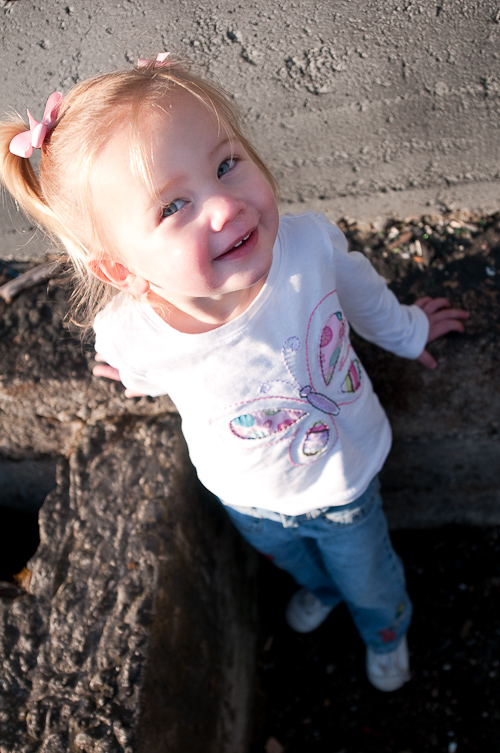

More Sewing - Crayon Roll
I recently tried my hand at crayon rolls. There are a ton of tutorials out there. I looked at tutorials from Skip To My Lou and Chocolate On Your Cranium. I decided to go with the tutorial from Skip To My Lou.
Here is the practice one that I made. It was pretty easy. I had a little trouble with the fabric shifting a little while sewing. I think I didn’t use enough pins. It was also a little touch to top stitch since the fabric as so thick, esp. in the corners. Yes, I did clip my corners. I just sewed really slowly and used my hand crank. (Is that what it’s called? That wheel that’s on the side of your sewing maching?)

Here is the next one I made. It was for a birthday gift. I know…I know…my sewing was a little crooked on the right hand edge.
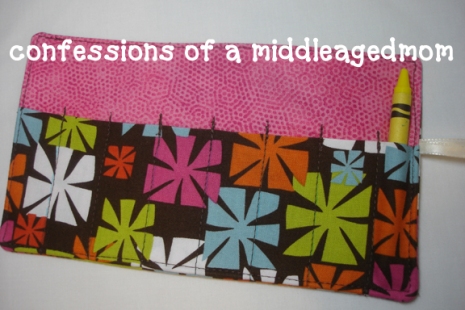
Here it is filled with crayons. I’m loving it. It’s pretty fun to make.

Here is the crayon roll all tied up. I think I’ll make the ribbon a little longer. I’ve seen some crayon rolls with elastic and button closures. I’ve also seen some variations with velcro. I kind of like the velcro closure for children to open and close it independently.

I used an 8 pack of crayons for my crayon roll. Most tutorials use 16 packs. But for little ones I felt like 8 was enough. My Baby is always losing her crayons so I thought sticking to less means less to handle for them and less to find for us parents.
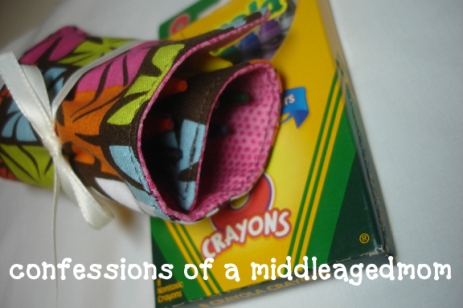
The crayon roll went with a little drawing pad and some other goodies as part of a birthday present for Baby’s BFF.
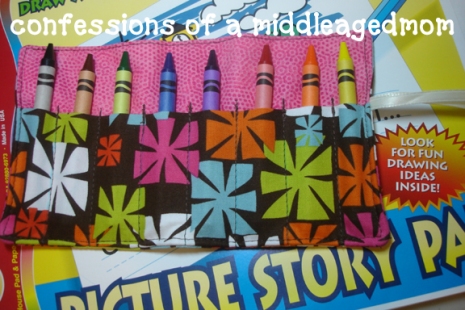
I have a bunch more crayon rolls to make. The other one I made I used ric rac on the edge. That wasn’t quite as easy. I’ll post those pics later. Other than that, it’s a pretty simple and fun sewing project.
I’m off now since I hear Baby fussing in her crib…calling “Mommy down!”